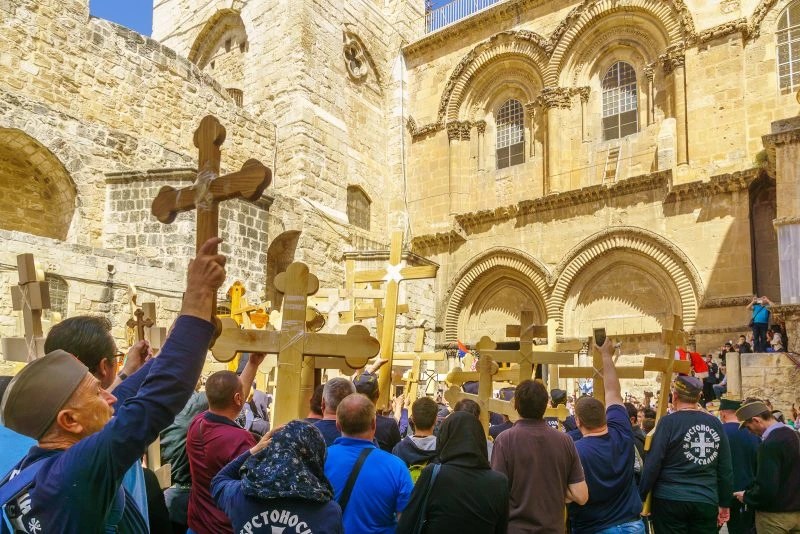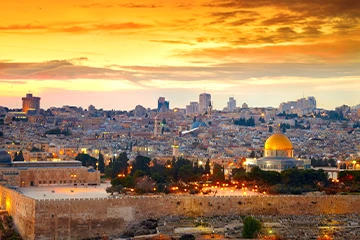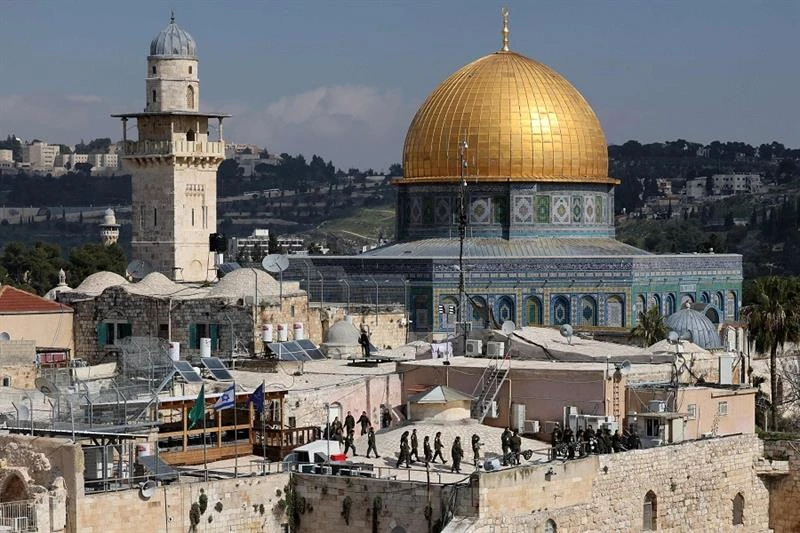Jerusalem is among the oldest and most important cities in the world, spiritually and historically, for the Jews, Christians, and Muslims. It is recognized as a holy city with some of the most famous religious places worldwide, such as the Western Wall, the Church of the Holy Sepulchre, and the Dome of the Rock. In holy land day tours, For Christians, Jerusalem is the heart of the Holy Land; within it, one finds Via Dolorosa and Mount Golgotha. For Muslims, it is the place of the Islamic Holy Land, with the Al-Aqsa Mosque and the Dome of the Rock bearing witness to faith. Jerusalem is a city of ancient history and a religiously diverse and vibrant culture, making it one of the best places to visit for anyone wanting to find an understanding of faith and history while stimulating the human spirit. Walking through the curvy streets of the Old City or taking part in some of its rich traditions will certainly bring visitors a memorable experience on their holy land travel through the heart of the three great monotheistic religions of the world.
Jerusalem's Religious Significance: A City for Jews, Christians, and Muslims
In the hearts and minds of the three major monotheistic religions: Judaism, Christianity, and Islam, Jerusalem is uniquely different. This is due to the historical and spiritual significance of the city, as it turns sacred to millions.
For Jews, Jerusalem is the site of the ancient Temple Mount—the place where stood both the First and the Second Temples. The last remnants of the Temple, the Western Wall, is among the holiest of Judaism and a sacred place for prayer and reflection.It is a historic city for Jews, as it was formerly the capital of the Kingdom of Israel and is associated with many important events narrated in the Hebrew Bible.
For Christians, Jerusalem is the land where Jesus Christ lived, died, and resurrected. The Church of the Holy Sepulchre, which is found at the very center of Old City, is one of the major places in Christianity where it is thought to be the site of Jesus' crucifixion, burial, and resurrection. In addition, the Via Dolorosa, which signifies the pathway Jesus trekked during his course to crucifixion, made it an important pilgrimage site for Christians worldwide.
For Muslims, Jerusalem is the empty place where the Dome of the Rock and the Al-Aqsa Mosque are situated. The Dome of the Rock is the site where the Prophet Muhammad ascended to heaven during the Night Journey. The Al-Aqsa Mosque, also nearby, is the third-most holy site in Islam after Mecca and Medina. Islamic heritage has a very significant part in the religious multiformity of this city as it is important for Muslims.
Exploring Jerusalem's Sacred Sites: Must-Visit Locations
1. The Wailing Wall (or Western Wall)
The Wailing Wall, which is also popularly called the Western Wall, is regarded as one of the most holy sites in Judaism. It is conserved as the remnant of the Second Temple, at which the Jews globally pray and hold reflections for themselves. Visitors are known to write their own prayers on small pieces of paper and leave them in the cracks of the wall according to the age-old tradition.
2. The Church of the Holy Sepulchre
Thus, it is an important pilgrimage church in Christianity, especially since it is identified with the two locations, Golgotha for the crucifixion of Jesus and the burial tomb. Thus, somehow, it embodies fascinating ancient architecture and becomes the nucleus of worship for Christians, attracting millions of visitors almost every year, especially during Easter.
3. The Dome of the Rock
It is located on Mount Temple; the Dome of the Rock is one of the most significant landmarks in all of Jerusalem. Moreover, it has immense meanings in both the Islamic and the Jewish Muslim worlds. For Muslims, the spot is said to be where the Prophet Muhammad ascended into heaven during his Night Journey. However, for Jews, Itamar is believed to have been where Abraham prepared to provide his son Isaac as a burnt offering. Indeed, the mosque is quite famous for its impressive gold-plated dome and beautiful mosaics.
4. Al-Aqsa Mosque
The third holiest site for Islam, after Mecca and Medina, is the Al-Aqsa Mosque, which is located adjacent to the Dome of the Rock. It is indeed a holy place of worship for Muslims and is known for its beautiful architecture and historical significance. The mosque stands on the ruins of the ancient Jewish Temple and is an integral part of the religious landscape of Jerusalem.
5. Via Dolorosa
The Via Dolorosa is the most significant pilgrimage path for Christian devotees. It is associated with the way Jesus is said to have walked on his way to the crucifixion: the route runs from the Antonia Fortress to the Church of the Holy Sepulchre within the Old City. At various stations along this route, pilgrims recognize particular events of the last journey of Jesus.
6. Mount Zion
Especially for Christians and Jews, Mount Zion is of religious import. Critical sites here include the Cenacle, the putative site of the Last Supper, and the Tomb of King David. Mount Zion is also the site to which one comes for resplendent views of the Old City walls and of the city, making it an oasis of peacefulness and contemplation.
7. The Garden of Gethsemane
At the foot of Mount Olives lies the Garden of Gethsemane, an extremely important Christian site where Jesus, who is said to have prayed there before His arrest, narrated. The garden is filled with ancient olive trees, some of which are believed to be over 2000 years old. Its uniqueness is in offering a very tranquil and contemplative atmosphere for reflection.
8. Mount of Olives
Mount of Olives overlooks the Old City and is home to some very significant Christian sites, including the Chapel of the Ascension—that spot believed where Jesus ascended into heaven—and the Church of All Nations (marking where he prayed before being taken). It is one of the more important Jewish places to bury people, with thousands of graves from ancient times.
9. The Pool of Bethesda
The Pool of Bethesda is an archaeological site important in Christian tradition in the Old City of Jerusalem. Here, it is said that Jesus healed a paralyzed man, as narrated in the Gospel of John. The remains of five porticos, which make up the pool today, bear testimony to the Biblical past of this city.
10. The Tower of David Museum
Near the Jaffa Gate, a visit to the Tower of David Museum offers a great introduction to the history of Jerusalem from ancient to modern times, within a medieval fortress. It opens it to an entirely unique understanding of this city as the rich confluence of cultures and religions. There are also breathtaking views of the Old City from the tower.
Jerusalem’s Vibrant Culture and Traditions
1. Religious Festivals
Jerusalem celebrates its religious festivals that reflect the many religions that live in the city. For Jews, there are Passover, Yom Kippur, or Hanukkah, in which they celebrate much more vibrantly with lively prayers at the Western Wall and sites. For Christians, there are Easter and Christmas, where there are processions and ceremonies within the Church of the Holy Sepulchre. Thus, pilgrims have all reason to visit Jerusalem. The holiest month of all for Muslims is Ramadan, which culminates in Eid al-Fitr, and all the mosques hold congregational prayers at Al-Aqsa.
2. Vintage Market and Food
Moving about is one of the ways to experience Jerusalem culture, more so in the Old City. The Mahane Yehuda Market, better known as "The Shuk," is known for an explosion of colors, smells, and tastes. Here you can find everything from fresh produce and spices to traditional pastries and snacks like falafel, hummus, and shawarma. Fortunate enough to be found in one such area, the market serves as a nexus where all locals come together to do whatever they can—shopping, chatting, or simply enjoying the vibrant atmosphere. Jerusalem's gastronomy bears the stamp of its multicultural population, being totally dependent on Jewish, Arab, Christian, and even Armenian tradition.
3. Arts and Music
Art and culture abound in the city as Jerusalem draws from a rich and diverse cultural heritage expressing both traditional and modern artistic forms. Annually, Jerusalem adds many more art galleries and museums, which have been its strongholds since time immemorial. Galleries include the Israel Museum, where one finds among the world's major collections of archaeology, art, and Judaica. Yad Vashem Memorial stays most Bethel commemorating, and the Jerusalem Theater hosts theatre, dance, music, and film events. Traditional music is characterized.
4. Religious Rituals and Practices
The culture of Jerusalem is best expressed in its religious rituals. Shabbat, for example, is practiced by Jewish communities throughout the city with the lighting of candles, family meals, and prayers at synagogues. During Holy Week, Christian pilgrims flock to the city of Jerusalem to walk along the Stations of the Cross. They would then attend the Easter Vigil or Christmas Eve Mass in other places. The echoing call to prayer that rings in the five daily prayers of a Muslim is heard throughout the city, especially from the Al-Aqsa Mosque. These sources of worship and rituals create the devotion rhythm to which the inhabitants of the city connect their souls to others and to faith.
5. Cultural Celebrations and Events
Cultural events are host to Jerusalem throughout the year, and there are many for people from different backgrounds. Example: The Jerusalem Film Festival, an event for international Israeli cinema, combines the art of music, dance, and theater from local and international venues. The book fair in Jerusalem attracts literary enthusiasts, and Jerusalem's Light Festival turns the historic sites of the city into beautiful works of art through installation light. It also enters the mind and spirit of the creativeness of the city as well as that of open dialogue and cultural exchange between many communities.
6. Religious Pilgrimages
There is no church more popular as the place of pilgrimage than Jerusalem, bathed in the culture that millions of pilgrims pour into the city each year. The Jew worships through the Western Wall on high holidays and during a bar/bat mitzvah. They also follow the Via Dolorosa and visit the Church of the Holy Sepulchre. Muslims come to pray in Al Aqsa, the Dome of the Rock Mosque, and the most sacred treasures of all Christian churches: to pray in Jerusalem are those found in the Houses of God built in the image of their Sons.
7. Diversity and Community
Jews, Muslims, Christians, Armenians, and many other ethnic and religious groups make up the rich diversity of the city of Jerusalem. While ensuring that each community continues with its traditions, they blend into what is called the city's culture. The neighborhoods include the following: the Jewish Quarter, the Christian Quarter, the Muslim Quarter, and the Armenian Quarter. Each has its distinctiveness with special cultural practices. This diversity finds expression through common festivities, interfaith dialogues, and cooperative efforts to preserve the heritage of the city.
8. The Spiritual and Daily Life
Jerusalem is usually a city where all daily life is mingled with the observances of religion. It is an environment that creates the call to prayer in the Al-Aqsa Mosque, the lighting of Shabbat candles, and the ringing of church bells within the city. Modernity has made coexistence with these practices in the city create a perfect balance between the ancient traditions and contemporary urban life.
The effect that Jerusalem shall eternally hold on faith and on humankind is as great as the continued light it remains over millions throughout the world. For Jews, Christians, and Muslims alike, the city stands for how great a physical and emotional manifestation of devotion, history, and hope may infuse a spiritual existence on individuals and of whole communities. The sacred sites, the deep-rooted traditions, the connections to events vindicated in biblical terms and tied to religious historical significance, have made Jerusalem a destination for pilgrimage for so long, thereby establishing that equal sense of faith and reverence amongst. Beyond its spiritual importance, whatever is there to call cultural or historical legacies of Jerusalem consequence have influenced art, philosophy, and human evolution, making it timeless. Such has made this city a dimension beyond measure within existence across borders and generations.Such a presence is meant to motivate, unify, and challenge even those who are seeking within a highly complex world for meaning and understanding. The Holy Land package makes it an intense trip for pilgrims to relive these sacred connections, with great possibilities for deepening one's spiritual journey across Jerusalem and its immediate surroundings.


--webp.webp)






-webp.webp)


